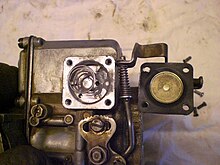Accelerator pump
An acceleration pump is a part of carburetors on internal combustion engines .
It ensures that if the throttle valve opens suddenly (e.g. to accelerate the vehicle), additional fuel is injected into the air funnel of the carburetor. Reason is that otherwise entering emaciation of the fuel-air mixture through the additional amount of air that the main nozzle due to the pressure balance in the intake system can not compensate. This can lead to a disruption of the mixture formation and the engine would stop for a short time.
Acceleration pumps are piston or diaphragm pumps that are connected to the throttle valve via a linkage. They have a leak opening through which the delivery rate flows off at low actuation speed.
A carburetor that does not require an accelerator pump is the constant pressure carburetor , in which the piston valve, which is oil-damped in some designs (e.g. Stromberg carburettor ), reacts with a delay to the changed load condition and therefore the pressure difference conveying the fuel is briefly higher. Constant pressure carburetors therefore react more slowly to the rapid opening of the throttle valve when accelerating.
literature
- Max Bohner, Richard Fischer, Rolf Gscheidle: Expertise in automotive technology. 27th edition, Verlag Europa-Lehrmittel, Haan-Gruiten 2001, ISBN 3-8085-2067-1

